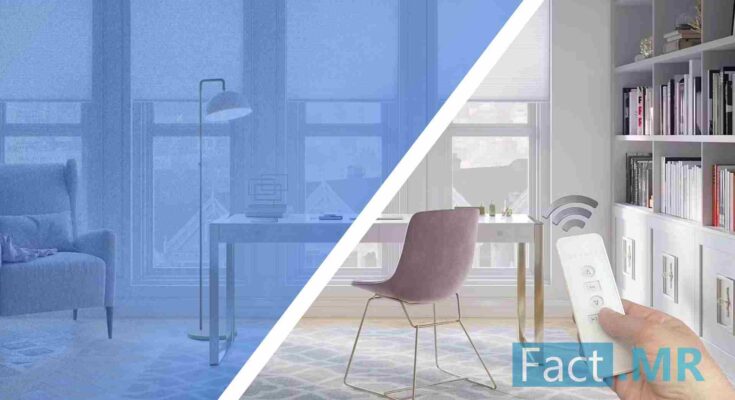Smart shades, also known as motorized or automated shades, are window coverings that can be controlled remotely or programmed to open and close automatically. These shades are equipped with motorized mechanisms that allow them to be operated using a remote control, smartphone app, or even voice commands through smart home systems like Amazon Alexa or Google Assistant.
Smart shades offer convenience and flexibility in controlling natural light, privacy, and energy efficiency in a home or office setting. They can be easily adjusted to let in or block out sunlight, provide privacy, and regulate the temperature inside a room. Some smart shades also have sensors that can automatically adjust based on lighting conditions or time of day.
In addition to manual control, smart shades can be integrated into smart home systems, allowing users to create schedules or scenes that automate the opening and closing of the shades. For example, one can program the shades to open in the morning to let in natural light and close in the evening for privacy.
Smart shades come in various styles, including roller shades, cellular shades, and Roman shades, and can be customized with different fabrics, colors, and opacity levels to suit individual preferences and interior design aesthetics.
The Growing Demand for Smart Shades can be Attributed to Several Factors
1. Convenience: Smart shades offer a convenient way to control window coverings without the need for manual operation. With the ability to control them remotely through a smartphone app or integrate them into a smart home system, users can easily adjust their shades from anywhere in the house or even when they are away.
2. Energy Efficiency: Smart shades can contribute to energy savings by allowing users to optimize natural light and heat gain. By automatically adjusting the shades based on lighting conditions or time of day, they can help regulate the temperature inside a room and reduce the need for artificial lighting or excessive air conditioning.
3. Privacy and Security: Smart shades provide enhanced privacy and security by allowing users to easily control the amount of visibility into their homes. With the ability to open and close the shades remotely, users can prevent outsiders from peering inside and maintaining their privacy.
4. Integration with Smart Home Systems: The increasing popularity of smart home systems has also contributed to the demand for smart shades. Integration with platforms like Amazon Alexa or Google Assistant allows users to control their shades through voice commands, create automation routines, or even synchronize them with other smart devices in their homes.
5. Aesthetics and Customization: Smart shades come in various styles, fabrics, and colors, allowing users to customize their window coverings to match their interior design preferences. This customization option appeals to homeowners who seek both functionality and aesthetics.
6. Technological Advancements: As technology continues to advance, smart shades are becoming more affordable, reliable, and user-friendly. The availability of wireless connectivity options and improved motorized mechanisms has made smart shades more accessible to a broader range of consumers.
Smart blinds are beneficial in various ways and can be used in different settings
Here are some examples of various applications of smart blinds:
1. Home: Smart blinds offer convenience and energy efficiency in residential settings. Homeowners can easily control their blinds using a smartphone app or integrate them into a smart home system. They can automate the opening and closing of blinds based on time of day, and lighting conditions, or even synchronize them with other smart devices. Smart blinds also provide enhanced privacy and security by allowing homeowners to control visibility into their homes.
2. Offices: Smart blinds are commonly used in office spaces to regulate natural light and create a comfortable working environment. They can be programmed to adjust based on the position of the sun, reducing glare on computer screens and minimizing the need for artificial lighting. Smart blinds also contribute to energy savings by optimizing the use of natural light and reducing HVAC load.
3. Hospitality Industry: Hotels, resorts, and other hospitality establishments can benefit from smart blinds in multiple ways. They can offer guests a convenient and personalized experience by allowing them to easily adjust the blinds in their rooms for privacy and comfort. Smart blinds can also contribute to energy efficiency by automatically adjusting based on occupancy and daylight conditions.
4. Healthcare Facilities: In healthcare settings, smart blinds can help create a soothing and comfortable environment for patients. They can be programmed to adjust lighting levels and privacy in patient rooms, waiting areas, and treatment rooms. Smart blinds can also be integrated with healthcare systems to automate the opening and closing of blinds during specific procedures or for patient privacy.
5. Educational Institutions: Smart blinds are increasingly being used in schools and universities to optimize natural light and create a conducive learning environment. They can be programmed to adjust based on classroom occupancy, time of day, or specific lighting requirements. This can improve student concentration, reduce eye strain, and contribute to energy efficiency.
Smart blinds are beneficial in various settings, including residential homes, offices, hospitality establishments, healthcare facilities, and educational institutions. They provide convenience, energy efficiency, enhanced privacy, and customization options that cater to the specific needs of each environment.
Here are some Current Trends in the World of Smart Blinds/Shades:
1. Integration with voice assistants: Smart blinds are increasingly being designed to work seamlessly with popular voice assistants like Amazon Alexa, Google Assistant, and Apple Siri. This integration allows users to control their blinds using voice commands, adding a new level of convenience and hands-free operation.
2. Enhanced automation and scheduling: Smart blinds are becoming more intelligent and capable of automation. They can be programmed to open and close at specific times of the day, adjust based on daylight conditions, or even respond to weather changes. This automation feature allows users to effortlessly manage their blinds without manual intervention.
3. Energy efficiency and sustainability: With the growing emphasis on energy conservation, smart blinds are being designed to contribute to energy efficiency. They can automatically adjust to optimize natural light, reducing the need for artificial lighting and minimizing the load on HVAC systems. This helps to save energy and lower utility bills.
4. Integration with smart home systems: Smart blinds are increasingly compatible with comprehensive smart home systems, allowing users to control multiple devices and create customized scenes. This integration enables users to synchronize their blinds with other smart devices like lighting, thermostats, and security systems, creating a more cohesive and efficient smart home experience.
5. Remote access and control: The ability to control smart blinds remotely through smartphone apps or web interfaces is gaining popularity. This feature enables users to operate their blinds from anywhere, providing convenience and flexibility. It is particularly useful when users are away from home and want to adjust their blinds for security or energy-saving purposes.
6. Customization and design options: Smart blinds are now available in a wide range of styles, materials, and designs, allowing users to choose options that match their interior decor and personal preferences. From roller blinds to Roman shades, users can find smart solutions that blend seamlessly with their aesthetic choices.
7. Improved motorization technology: Smart blinds are incorporating advanced motorization technology, resulting in quieter and smoother operation. Motors are becoming more reliable and efficient, ensuring long-lasting performance and durability.
These trends highlight the continuous evolution of smart blinds/shades, offering users more convenience, energy efficiency, customization options, and seamless integration with other smart home devices.
Also Read- Smart Shoes: Revolutionary Trends & Growth of the Fitness & Footwear Industry


